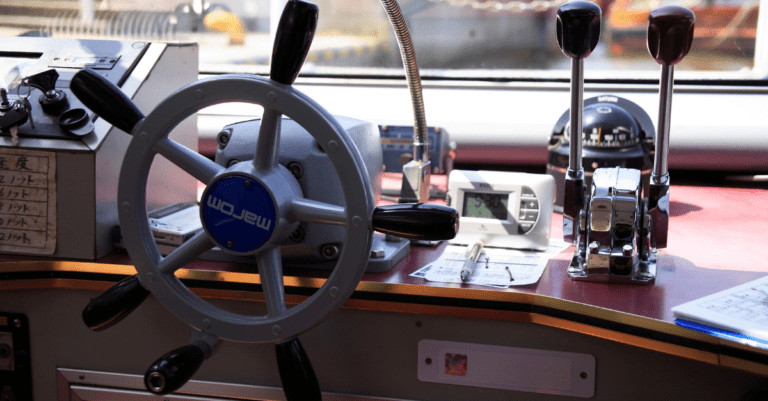Have you ever wondered about the term “wheelhouse?” Our listener named Heidi did. She asked, “Have you guys noticed the term ‘wheelhouse’ being tossed around a lot lately? It seems to be the business meeting/pop culture buzzword du jour. I’m wondering if you’ve noticed the same and if so, if you have any theories on why that is.”
Heidi, this term is definitely in frequent use. I can’t tell you why it’s so popular, but I can tell you where it came from.
A wheelhouse is exactly what it sounds like: the little “house” on a ship where the captain stands, and where the ship’s wheel and other navigational equipment are located. That’s where the Skipper stood on the S.S. Minnow, and where Captain Merrill Stubing stood on the Pacific Princess — aka, the Love Boat. dragonflyeditorial.com
A wheelhouse is the location of a ship’s wheel.
Although people have been steering ships for centuries, the term “wheelhouse” appeared for the first time in the early 1800s. In 1840, a traveler on a ship that burned and sank in Long Island Sound wrote a letter of complaint to Daniel Webster, then U.S. Secretary of State. The ship’s captain “seemed confused,” the traveler wrote. “He went into the wheel house, and that was the last I saw of him. I rather think he stayed there until he suffocated.”
In actuality, he didn’t suffocate. He was one of only four people who escaped. All 136 other people on board died in the cold January waters.
In the 1950s, baseball announcers started using the term ‘wheelhouse.’
For some reason, in the 1950s, this term was picked up by baseball announcers and reporters. They began to refer to a batter’s “wheelhouse,” by that meaning the area of the strike zone where a batter swings with the most power. (Reporters also called this area the “crush zone” and the “kill zone,” by the way.) Those phrases seem pretty obvious, but we don’t know how the “wheelhouse” analogy got started. But if you imagine a sea captain or helmsman standing in front of the ship’s wheel, you can see how the wheel forms a sort of target in front of the midsection. Maybe that image inspired reporters.
Another theory, described in the Dickson Baseball Dictionary, is that batters “‘wheel’ at the ball, taking good, level ‘roundhouse’ swings.” Perhaps this “wheeling” suggested the association.
In the 1980s, ‘wheelhouse’ started being used to describe a person’s areas of expertise.
Either way, in the 1980s, the meaning of this term extended once again. It came to mean, and still means, an area or field in which a person excels. You could say that “grammar is my wheelhouse,” for example. Or that teaching people to write is “in my wheelhouse.”
Notice that you can use this phrase in one of two ways. You can say something “is your wheelhouse” or that something “is in your wheelhouse.” Either version is correct, but “in your wheelhouse” may be a little more common.
In answer to Heidi’s question about whether this is the business buzzword du jour … I’m not sure. But let’s all make a mutual pact to not say it too often. It’s a fun, vivid image, and I’d hate for it to undergo semantic bleaching like we talked about last time.
Sources
Dickson, Paul. The Dickson Baseball Dictionary, 3rd ed. WW Norton & Col, 2011 (accessed August 30, 2019).
Anon. Letter to The Hon. Daniel Webster, on the causes of the Destruction of the Steamer Lexington. pp. 18. Charles C. Little and James Brown, 1840 (accessed August 30, 2019).
Higgins, Chris. What’s a ‘Wheelhouse’ and Why is Something in Mine? Mental Floss, Sept. 27, 2015 (accessed August 30, 2019).
Oxford English Dictionary, online edition. Oxford University Press. Wheelhouse (subscription required, accessed August 30, 2019).
Image courtesy of Shutterstock.




